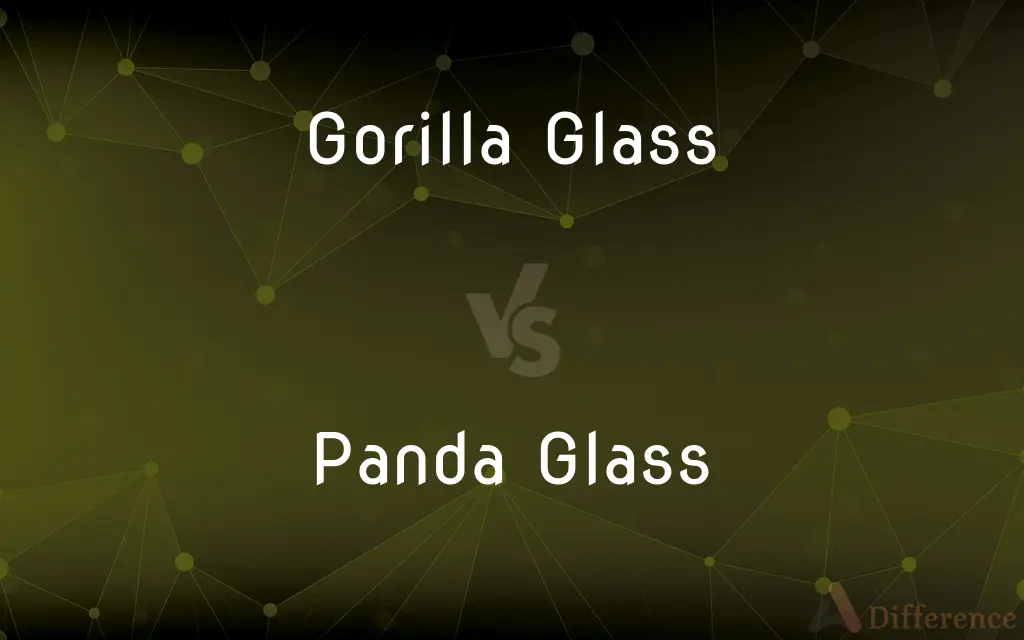Gorilla Glass vs. Panda Glass — What's the Difference?
By Tayyaba Rehman & Fiza Rafique — Published on October 16, 2023
Gorilla Glass is a durable, scratch-resistant glass developed by Corning, while Panda Glass, produced by Tunghsu Optoelectronic, is also a sturdy glass but made using alumino-silicate materials.

Difference Between Gorilla Glass and Panda Glass
Table of Contents
ADVERTISEMENT
Key Differences
Gorilla Glass is a trademarked product developed by Corning Incorporated and is recognized globally for its resistance to damage and lightweight nature. On the other hand, Panda Glass is a product from Tunghsu Optoelectronic and stands out for its manufacturing process involving alumino-silicate.
When considering their applications, Gorilla Glass has been the preferred choice for many electronic device manufacturers due to its enhanced durability and proven track record. Meanwhile, Panda Glass is gaining traction in various industries and is touted for its high transparency and conductive properties.
In the ever-evolving technology industry, the demand for durable materials like Gorilla Glass and Panda Glass is on the rise. Both these glasses have emerged as top contenders, offering significant resistance to wear and tear, scratches, and impacts.
It's essential to understand that while both Gorilla Glass and Panda Glass aim to provide durable solutions for electronic devices, their chemical compositions and production techniques vary. This difference leads to subtle distinctions in their performances and applications.
Finally, both Gorilla Glass and Panda Glass are innovations borne out of the necessity for resilient materials in the tech world. While the former has been around longer and enjoys widespread recognition, the latter is carving a niche for itself with its unique properties.
ADVERTISEMENT
Comparison Chart
Developer
Corning Incorporated
Tunghsu Optoelectronic
Composition
Specialized glass composition
Alumino-silicate glass
Recognition
Widely recognized globally
Emerging and gaining recognition
Predominant Feature
Scratch and impact resistance
High transparency & conductivity
Industry Use
Primarily electronic devices
Diverse applications including electronics
Compare with Definitions
Gorilla Glass
Recognized for its scratch-resistance.
She chose that tablet because of its Gorilla Glass screen.
Panda Glass
Offers significant conductivity.
Panda Glass is not only transparent but also impressively conductive.
Gorilla Glass
A leader in damage-resistant screens.
Opting for Gorilla Glass is always a wise choice for longevity.
Panda Glass
Known for its high transparency.
The crystal clear clarity of Panda Glass is commendable.
Gorilla Glass
Often used in consumer electronics.
Gorilla Glass ensures that the device screen remains pristine over time.
Panda Glass
An emerging competitor in the durable glass market.
With advancements, Panda Glass might give other brands a run for their money.
Gorilla Glass
A durable glass made by Corning.
Many smartphones are equipped with Gorilla Glass for added durability.
Panda Glass
Produced by Tunghsu Optoelectronic.
Panda Glass, a product of Tunghsu, is making waves in the industry.
Gorilla Glass
A blend of thinness and toughness.
Despite its sleek appearance, Gorilla Glass can withstand considerable pressure.
Panda Glass
A type of durable alumino-silicate glass.
He was intrigued by the resilience of Panda Glass.
Common Curiosities
What is the primary component of Panda Glass?
Panda Glass is primarily made from alumino-silicate materials.
Which glass is more widely recognized in the industry?
Gorilla Glass is more widely recognized due to its longer presence in the market.
Are both glasses used in smartphones?
Yes, both Gorilla Glass and Panda Glass are used in smartphones and other electronic devices.
Who manufactures Gorilla Glass?
Gorilla Glass is manufactured by Corning Incorporated.
Are there different versions of Gorilla Glass?
Yes, there are multiple versions of Gorilla Glass, each with enhanced features and improvements.
How do the manufacturing processes of the two differ?
While both involve intricate processes, the primary difference lies in their compositions and the techniques adapted for their properties.
Which glass boasts higher transparency?
Panda Glass is known for its high transparency.
How do the thicknesses of the two glasses compare?
Both glasses are designed to be thin yet durable, but exact thickness can vary based on the application and version.
Which glass offers better resistance to scratches?
Both glasses offer scratch resistance, but Gorilla Glass is particularly touted for this feature.
Are there any environmental concerns associated with the production of these glasses?
Like all manufacturing, there can be environmental considerations, but companies often adopt measures to minimize impact.
How does the durability of Panda Glass compare to Gorilla Glass?
Both glasses are designed for durability, but specific performance can vary based on the version and application.
Do manufacturers charge more for devices with Gorilla Glass?
The presence of Gorilla Glass can be a premium feature, potentially influencing the device's price.
Is Panda Glass a newer product in the market?
Yes, compared to Gorilla Glass, Panda Glass is a relatively newer entrant.
Can these glasses be used beyond electronic devices?
While commonly used for electronics, both glasses have potential for other applications, given their properties.
Can users easily distinguish between devices using Gorilla Glass and Panda Glass?
It might be challenging for an average user to distinguish based solely on appearance; product specifications or branding can provide clarity.
Share Your Discovery

Previous Comparison
Gross Income vs. Net Income
Next Comparison
Washington vs. Washington DCAuthor Spotlight
Written by
Tayyaba RehmanTayyaba Rehman is a distinguished writer, currently serving as a primary contributor to askdifference.com. As a researcher in semantics and etymology, Tayyaba's passion for the complexity of languages and their distinctions has found a perfect home on the platform. Tayyaba delves into the intricacies of language, distinguishing between commonly confused words and phrases, thereby providing clarity for readers worldwide.
Co-written by
Fiza RafiqueFiza Rafique is a skilled content writer at AskDifference.com, where she meticulously refines and enhances written pieces. Drawing from her vast editorial expertise, Fiza ensures clarity, accuracy, and precision in every article. Passionate about language, she continually seeks to elevate the quality of content for readers worldwide.
















































